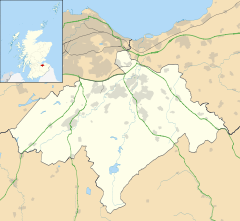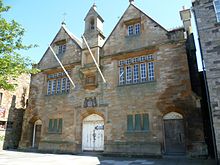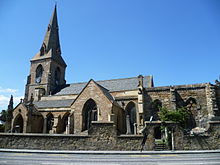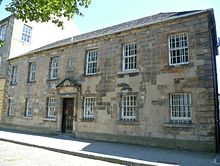- Dalkeith
-
This article is about the town in Scotland. For other places named Dalkeith, see Dalkeith (disambiguation).
Coordinates: 55°53′45″N 3°03′30″W / 55.8958°N 3.0583°W
Dalkeith Scottish Gaelic: Dail Cheith
 Dalkeith shown within Midlothian
Dalkeith shown within MidlothianPopulation 11,566 (2001 census) Council area Midlothian Lieutenancy area Midlothian Country Scotland Sovereign state United Kingdom Post town DALKEITH Postcode district EH22 Dialling code 0131 Police Lothian and Borders Fire Lothian and Borders Ambulance Scottish EU Parliament Scotland List of places: UK • Scotland • Dalkeith (Scottish Gaelic: Dail Cheith) is a town in Midlothian, Scotland, lying on the River North Esk. It was granted a burgh of barony in 1401 and a burgh of regality in 1540. The settlement of Dalkeith grew southwestwards from its 12th-century castle (now Dalkeith Palace). Dalkeith has a population of 11,566 people according to the 2001 census.[1]
The town is divided into four distinct areas: Dalkeith proper with its town centre and historic core, with Eskbank to its west and Woodburn to its east. Eskbank is the well-heeled district of Dalkeith with many large Victorian and newer houses. To the south of Eskbank is Newbattle with its abbey. Woodburn could not be more different, being a working class council estate built from around 1935 onwards.
Dalkeith is the main administrative centre for Midlothian. It is twinned with Jarnac, France. In 2004, Midlothian Council re-paved Jarnac Court in honour of Dalkeith and Jarnac's long standing link.
There is an estate called Thornyhall on the edge of Dalkeith near the industrial estate beyond which is the newly-built Dalkeith Campus - housing the high schools of Dalkeith and St David's.
Contents
History
One of the earliest historical references to Dalkeith is found in the Chronicles of Jean Froissart. He writes of the battle of Otterburn and the death of James, Earl of Douglas:
"I, author of this book, in my youth had ridden nigh over all the realm of Scotland, and I was then fifteen days in the house of earl William Douglas, father to the same earl James, of whom I spake of now, in a castle of five leagues from Edinburgh which is called in the country Dalkeith. The same time I saw there this earl James, a fair young child, and a sister of his called the lady Blanche."[2]
In 1650, Cromwell's army came to Dalkeith.[citation needed] His officer General Monck, was Commander in Scotland, and the government of the country was based out of Dalkeith castle.[citation needed]
In the 17th century, Dalkeith had one of Scotland's largest markets in its exceptionally broad High Street.[citation needed]
In 1831, Dalkeith was linked to Edinburgh by a railway line that transported coal, minerals, and agricultural produce. Two decades later, in 1853, a Corn Exchange, the largest interior grain market in Scotland, was built.[citation needed]
In 1879, Dalkeith was where Gladstone first started his campaign for British Prime Minister, which became known as The Midlothian Campaign.[citation needed]
Notable buildings
The Collegiate Church of St Nicholas Buccleuch, formerly known as Dalkeith Parish Church, stands on High Street. Dedicated to St Nicholas, this medieval church became a collegiate establishment in 1406, founded by Sir James Douglas. The nave and transepts date from 1854, when the inside of the church was greatly altered. The chancel was abandoned in 1590, walled off from the rest of the church, and is now ruinous. Sir James Douglas, 1st Earl of Morton, and his wife Joanna, daughter of James I, are buried in the choir and have stone effigies. St Nicholas Buccleuch Church remains one of the two Church of Scotland parish churches in Dalkeith, the other being St John's and King's Park Church.
Dalkeith Palace which replaced the castle in the late 16th century and was rebuilt in the early 18th century, lies at the north-east edge of the town. It is a seat of the Duke of Buccleuch, surrounded by parkland and follies.
The building on High Street now known as the Tolbooth began to be used as a tolbooth for the administration of the town in the early 18th century. The plaque above the door reads '1648' but this was taken from another building and does not denote when the Tolbooth was built. It served as a place for law and order and featured a prison in the west half, a court room on the east, and a dungeon known as the ‘black hole’ below ground. In front of the building there is a circle of stones to mark the spot where the last public hanging in Dalkeith occurred in 1827.
Other notable buildings include Watch Towers at the cemetery (1827 and 1829) and early 19th century iron mills.
Notable people
Born in Dalkeith: the politician Henry Dundas, 1st Viscount Melville (1742), the artist John Kay (1742), Robert Aitken who published the first Bible in North America,[3] David Mushet, who pioneered iron production, and the mathematical physicist Peter Guthrie Tait (1831). Sir John Anderson (later 1st Viscount Waverley), Home Secretary (1939–1940), Chancellor of the Exchequer (1943–1945) was born in Eskbank in 1882. During the election campaign of 1880 (the "Midlothian campaign") that resulted in the defeat of Disraeli's government, William Ewart Gladstone delivered a famous speech in Dalkeith.
Recent notable people from Dalkeith include former Marillion lead singer Fish (born Derek Dick), Manchester United footballer Darren Fletcher, former lead singer of Scottish Gaelic rock band Runrig Donnie Munro[citation needed] and multi-millionaire Niall Malone who made his fortune working alongside Sir David Murray.
Transport
Until 2008, Dalkeith was on the A68, one of the main routes south from Edinburgh to Jedburgh and across the border to Darlington. A bypass to take traffic away from the town centre was completed in September, 2008; this then took the A68 number, and the old route of the A68 is now the A6106.[4]
Other main roads serving Dalkeith are:
- A6094 — leads SW towards Bonnyrigg and Peebles, and NE towards Musselburgh
- A768 — leads west from Eskbank to Lasswade and Loanhead
- B6373 — a road wholly within Dalkeith, leaving and rejoining the A6106
- B6414 — leaves the A6094 on the NE edge of Dalkeith (at Woodburn) and leads NE to Tranent
- B6392 — runs north–south through Eskbank, and is formerly the route of the A7 which leads from Edinburgh to Galashiels and Hawick
- B703 — leads south from Eskbank, through Newbattle, to Newtongrange
- B6482 — leaves the A6106 on the SE edge of Dalkeith (at Woodburn) and leads into Easthouses and Mayfield.
The planned re-establishment of the Waverley Railway Line will link Dalkeith to the national rail network, with a station at Eskbank on the western edge of Dalkeith.
Bus services in Dalkeith are mostly run by First Edinburgh and Lothian Buses; Munro's of Jedburgh also serve the town.
Sport
Football
Dalkeith is home to the junior football club Dalkeith Thistle. The club consistently finishes in the bottom two of the East Region South Division. Dalkeith Ladies Football Club formed in 2005, won the Scottish 3rd Division in season 2005-06 and finished Scottish 2nd Division runners up 2006-07. This season they are playing in the Scottish 1st Division and aim to consolidate their position having already reached the League Cup final only to lose out. Currently managed by ex-Scotland captain and Arsenal player Pauline MacDonald, the club is going from strength to strength attracting new players on a consistent basis.
Other teams in Dalkeith are the youth side Dalkeith Miners (Dalkeith CYP), whose ground is at Cowden Park, Woodburn, and amateur football team Salters AFC.[5]
Rugby
Dalkeith RFC is an amalgamation of two amateur rugby clubs, Dalkeith High School FPs and Dalkeith Rugby Football Club. The team plays in the Scottish Rugby Union East Leagues. The club was the first in Midlothian to open full membership to women and the first in the county to run a women's side. Notable former players include Sir David Murray, whose car crash on the way back from a match in North Berwick ended his rugby career and led to him focusing on his business empire. Adam Robson, who went on to become President of the Scottish Rugby Union also played for the club.
Gallery
Twin town
See also
References
- ^ "Comparative Population Profile: Dalkeith Locality Scotland". General Register for Scotland. 2001-04-21. http://www.scrol.gov.uk/scrol/browser/profile.jsp?profile=Population&mainLevel=Locality&mainText=dalkeith&mainTextExplicitMatch=false&compLevel=CountryProfile&compText=&compTextExplicitMatch=null. Retrieved 2007-03-09.
- ^ Froissart, Jean (1978). Chronicles of England France, Spain, etc.. Penguin Classics. ISBN ISBN 0-14-044200-6.
- ^ Who Was Who in America, Historical Volume, 1607–1896. Marquis Who's Who. 1967.
- ^ A68 Dalkeith Northern Bypass | Transport Scotland
- ^ "Salters Amateur Football Club, Edinburgh". Saltersafc.co.uk. 2011-05-22. http://www.saltersafc.co.uk/. Retrieved 2011-11-04.
External links
Categories:- Towns in Midlothian
Wikimedia Foundation. 2010.











